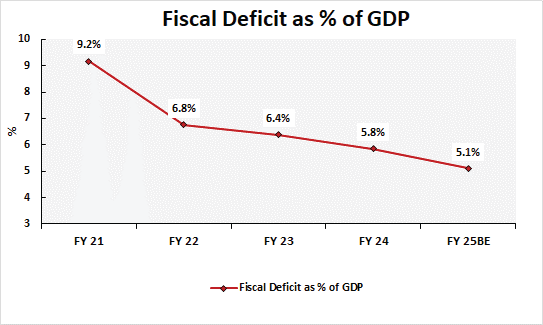
Macro and
Equity Market
Outlook
Equity Market
Outlook
GLOBAL MACRO & MARKETS
India’s NIFTY index ended the month flat in January 2024. The
S&P500 (+1.6%), the Euro 50 (+2.8%), the Morgan Stanley
Capital International World (MSCI) (+1.1%), and the Japanese
NIKKEI (+8.4%) rounded a positive month for major global
indices. Among Emerging Market (EM) indices, the Morgan
Stanley Capital International (MSCI) Emerging Markets, the
HANG SENG (Hong Kong) and the BOVESPA (BVSP) Brazil were all
down in January 2024 by -4.7%, -9.2% and -4.8%, respectively.
The Moscow Exchange (MOEX) Russia Index was up +3.7%, bucking
the trend for EMs.
London Metal Exchange (LME) remained flat (-0.8%) in January
2024, as top consumer China’s demand outlook remained tepid in
response to the property sector crisis in the country. West
Texas Intermediate (WTI) and Brent Crude rebounded over the
month, by +5.9% and +6.1% respectively as global oil markets
remained volatile based on the sustenance of The Organization
of the Petroleum Exporting Countries (OPEC+) production caps
and the situation in the Red Sea.
The US Dollar index strengthened by +1.9% through January
2024, with the US Dollar depreciating by -1.8% vis-à-vis
Emerging Market currencies and depreciating by -0.2% against
the Indian Rupee on the spot market. India 10Y G-Sec yields
fell by -0.2 bps, while US 10Y G-Sec yield rose by +23.9 bps,
and the German Bund yield rose by +26.6 bps, with rates
settling at 7.18%, 4.12% and 2.29% respectively. US yields
falling were a function of the expectations of the Fed’s
comments on potential rate cuts in 2024 with inflation
moderating sharper than expected.
Domestic Macro & Markets
The S&P BSE SENSEX (-0.7%) remained flat in January 2024. S&P
BSE Mid-cap and Small-cap indices outperformed the large cap
index, up +5.3% and 7.1% respectively. Sector-wise, Oil & Gas,
PSU, and Realty were the top 3 performers over the month,
clocking +12.6%, +11.2%, and +9.4%, respectively. 10 of S&P
BSE’s 13 sectoral indices ended the month in green.
Net Foreign Institutional Investors (FII) flows into equities
were negative for January 2024 (-$3.35 Bn in January 2024,
following +$5.85Bn in December). Domestic Institutional
Investors (DIIs) remained net buyers of Indian equities
(+$3.3Bn, from +$1.5Bn from last month).

India's high frequency data update:
Elevated levels of GST collections, festive season demand
uptick, stable retail inflation, deflated input inflation,
rising core sector outputs, and elevated credit growth augurs
well for the Indian economy.
Manufacturing PMI:
Manufacturing PMI in January 2024 recovered to 56.5, at a
four-month high and remained in expansion zone for the 31st
straight month driven by mild input cost inflation and surge
in new orders.
GST Collection:
Collections of INR 1.72 Tn (+10% YoY) in January 2024
concluded the twenty third consecutive month of collections
over the INR 1.4 Tn mark, following record collections of INR
1.87 Tn in April 2023. Collections for 8 out of 10 months in
this fiscal year crossed INR 1.6 Tn. Rising compliance,
increased formalization of the economy, festive demand, and
improved administrative efficiency have driven high tax
collection buoyancy.
Core sector production:
The index of eight core sector industries grew by 3.8% in
December 2023, against a 7.8% jump in November 2023, as an
unfavourable base effect came into play for India’s eight core
sectors. Seven of the eight constituent sectors recorded
positive YoY growths, with crude oil recording a YoY degrowth.
Industrial Production:
Manufacturing Output as measured by the IIP index decelerated
MoM to an eight-month low, with a rise of 2.4% in November
2023, vs a growth of 11.6% YoY in October, driven by muted,
but positive YoY growths in all 3 constituent sectors- Mining,
Manufacturing and Electricity.
Credit growth:
Scheduled Commercial Bank Credit growth reached 20.3% YoY as
of 12th January 2024 against a YoY growth of 16.47% as
observed on 13th January 2023.
Inflation:
December 2023 CPI inflation rate rose to a four-month high,
and reached 5.69%, accelerating from 5.55% in November 2023.
Food inflation remained elevated and accelerated, coming in at
9.53%. WPI inflation reached a nine-month high, with the
December print at +0.73%, 47 bps up from November’s at +0.26%,
as WPI inflation printed positive for the second month in a
row.
Trade Deficit:
Indian Merchandise Exports rose by +0.97% YoY to $38.45 Bn in
December 2023, while Imports fell by -4.85% YoY to $58.25 Bn.
Merchandise trade deficit narrowed to a $19.8 Bn as the global
economic situation remained uncertain.
Interim Budget for Fiscal 2024-25 key takeaways:
A well-balanced budget with commitment to fiscal
consolidation, policy continuity and macro stability
Amidst various uncertainties the Central Government
continued the path of fiscal consolidation. FY25 deficit was
set at 5.1% of GDP signalling the intent to get to the
medium term fiscal deficit target of 4.5% of GDP in FY26.
Fiscal math appears credible with very reasonable
assumptions on tax and non-tax revenues growth for FY25.
On the expenditure side the focus has been on the supply
side. Effective capex allocation has been increased by
nearly 17%yoy while revenue expenditure is budgeted to see
very modest growth in FY25.
Events to watch out for in January 2024:
Oil Prices:
The OPEC+ rolled over its production cut policy for the first
quarter of 2024, with expectations of a revisit in March of
2024. Current production cuts remain at 2.2 Mn BPD (Barrels
per day), with Saudi Arabia maintaining a 1 Mn BPD voluntary
cut in production. Talks of impeding ceasefire between Hamas
and Israel, the situation in the Red Sea, unforeseen refinery
shutdowns in the USA, US rate cut expectations etc may lead to
higher volatility in global markets.
China Macroeconomic situation:
China’s manufacturing activity contracted for the fourth month
in a row in January 2024, with the government’s fiscal
stimulus measures providing little support for a deflationary
situation that has enveloped the economy. Major Chinese
developer Evergrande’s $330 Bn default has also created a drag
on the property market of the country, which accounts for a
much as 20% of real activity in the country, according to the
IMF. Risks of contagion through the high-risk shadow banking
system in China remains a key monitorable for global equity
markets.
Monthly Performance for Key Indices:

Source: Bloomberg
.*Calendar year returns.
Note: Market scenarios are not reliable indicators for current or future performance. The same should not be construed as investment advice or as any research report/research recommendation.
Past performance may or may not be sustained in future.
Note: Market scenarios are not reliable indicators for current or future performance. The same should not be construed as investment advice or as any research report/research recommendation.
Past performance may or may not be sustained in future.
Market View
India continues to be one of the fastest growing major economy
supported by demographic advantage, deregulation & policy
reforms, digitization and demand (aspirational spending).
Overall outlook towards domestic capital markets remains
optimistic, supported by resilient domestic demand and the
signs of bottoming of global & domestic monetary tightening
cycle.
Prudent interim budget with a focus on fiscal consolidation,
policy continuity can help reduce external risks and aid in
attracting global investors.
Going forward the sentiment appears to buoyant supported by
India’s relatively better macros, possibility of higher
foreign flows and the narrative around policy continuity in
the upcoming general elections.
From an equity market perspective, some of the positives
appear to be considered in valuations and therefore return
expectations from near term perspective should be moderate.
We believe Large Cap oriented strategies appear to be better
placed on a risk- reward basis while Asset allocation products
can help to manage the downside risks
Asset allocation in line with investment goals and risk
appetite is important for better risk – return optimization.
Herein asset allocation funds can help in lowering volatility
and provide better balance to the overall portfolio mix.
Chart of the month :
Central Government chooses fiscal prudence over populism.
The path to fiscal consolidation continued in the interim
budget announcement, with the fiscal deficit reaching 5.8% in
2024, and estimated to be 5.1% of GDP in FY25. The Central
government remains on the fiscal glide path of 4.5% by FY26.

Source:
Budget Documents, BE – Budgetary Estimates, NIMF Research,
CEIC
Disclaimer: The information herein above is
meant only for general reading purposes and the views being
expressed only constitute opinions and therefore cannot be
considered as guidelines, recommendations or as a professional
guide for the readers. The document has been prepared on the
basis of publicly available information, internally developed
data and other sources believed to be reliable. The sponsors,
the Investment Manager, the Trustee or any of their directors,
employees, Associates or representatives (‘entities & their
Associate”) do not assume any responsibility for, or warrant
the accuracy, completeness, adequacy and reliability of such
information. Recipients of this information are advised to
rely on their own analysis, interpretations & investigations.
Readers are also advised to seek independent professional
advice in order to arrive at an informed investment decision.
Entities & their associates including persons involved in the
preparation or issuance of this material, shall not be liable
in any way for any direct, indirect, special, incidental,
consequential, punitive or exemplary damages, including on
account of lost profits arising from the information contained
in this material. Recipient alone shall be fully responsible
for any decision taken on the basis of this document.
*The sectors mentioned are not a recommendation to buy/sell
in the said sectors. Details mentioned above are for
information purpose only.
